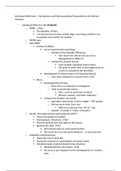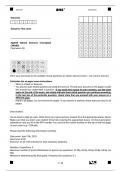Key definitions - Key words - Examples
Inhoudsopgave
Lecture 2 – Loss aversion framing of decisions ................................................................................................ 2
Lecture 3 – Mental accounting ....................................................................................................................... 4
Lecture 4 – System 1 & 2 and Heuristics & Biases ........................................................................................... 7
Lecture 5 – Heuristics and Biases (B) ............................................................................................................... 8
Lecture 6 – Fairness ...................................................................................................................................... 11
Lecture 7 – Visceral influences ...................................................................................................................... 12
Lecture 8 - Superforecasting ......................................................................................................................... 14
Lecture 9 – Motivated reasoning .................................................................................................................. 18
Lecture 10 – (Dis)Honesty ............................................................................................................................. 22
Lecture 11 – Money ...................................................................................................................................... 25
1
,Lecture 2 – Loss aversion framing of decisions
Types of decisions:
1. Major reflective decisions: invest in a stock/business, buy a house, medical decisions.
2. Low level decisions: shopping for groceries, what to wear, which way to go driving.
What should affect a decision?
- What you want and want to avoid.
- Strength of preferences and dislikes for particular outcomes
- What factor or events will affect whether the outcome will be good, mediocre, or
bad and to what degree. How likely are the different possibilities?
How should decision be made?
Rational decision-making process:
1. Define the problem
2. Identify the decision criteria
3. Weight the identified decision-making criteria
4. Generate possible alternatives
5. Rate each alternative against the decision maker’s criteria
6. Compute the optimal decision
Assumptions:
- The decision make is rational
- The problem is clear and unambiguous
- The decision maker has complete information
- No time or cost constraints
- Choice will be one with the maximum payoff
Normative decision analysis (What we should do!)
1. Enumerate (=opsommen) options
2. Enumerate outcomes
3. Construct a decision analysis for the decision
4. Evaluate the probabilities of different possible outcomes
5. Determine which option has the greatest ‘expected utility’
Expected utility theory
Dominance principle: alternative gambles ranked best to worst in terms of expected value.
Cancellation: a choice between gambles should depend only on those outcomes that differ,
not on outcomes that are the same for both alternatives. Common factors should cancel out.
Transitivity: if you prefer A to B and B to C, then you must prefer A to C.
Invariance: Preference should remain invariant/stable, no matter how choices are described.
Framing effect
Expected utility theory assumes description invariance: ‘different formulations of the same
choice problem should give rise to the same preference order’.
Evidence states that variations in the framing options (description) yield systematically
different preferences.
2
, Framing effect leads to violation of the invariance and the dominance axioms of expected
utility theory.
Value function: v(x-r) à r is the reference point
Loss aversion
The disutility (displeasure/pain) associated with a loss of a given amount is larger than the
utility associated with a gain of the same or similar magnitude.
Certainty effect
Reduction of probability of an outcome by a constant factor has more impact when the
outcome was initially certain than when it was merely probable.
Pseudo-certainty effect
Discrepancy in response to objectively identical problems. The potential ‘certainty’ is
contingent upon reaching the second stage of the game (still uncertain).
Gains, losses and adaptation
Difference between a 8m and 10 m prison cell is insignificant when one has just lost
freedom. But very important after adapting to new level.
Status quo
We want to keep things the way they are; even if we didn’t originally choose it.
We want to avoid potential losses generated by change; losses loom larger than gains
3











